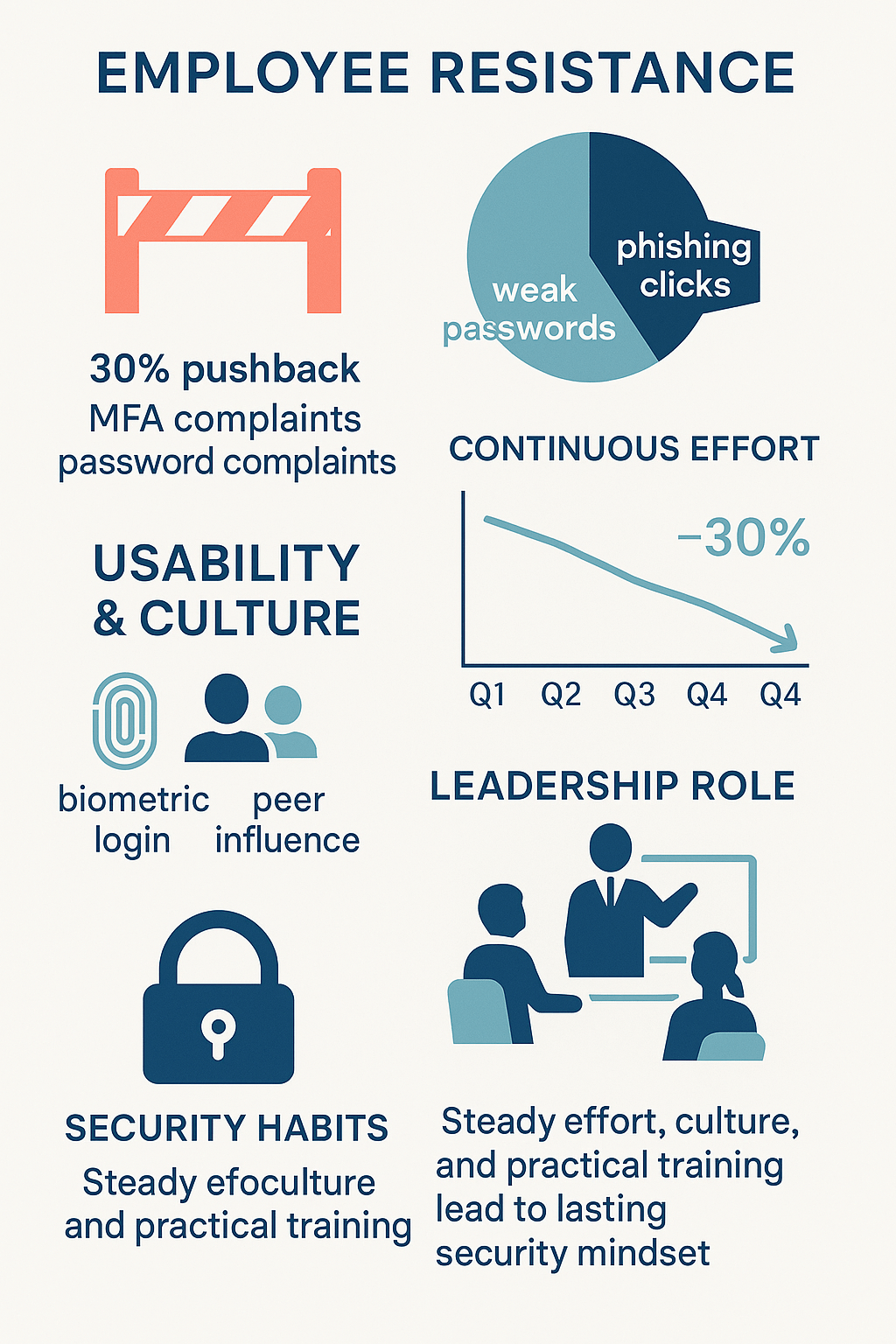
Building a security mindset isn’t something that happens overnight. It’s a tangled web of challenges,employees pushing back, mistakes slipping through, and systems that just don’t feel user-friendly. Many folks see security rules as just red tape, not something that actually protects them.
Then, cyber threats keep changing, so training has to keep up, which isn’t easy. On top of that, social habits and culture shape how people behave online, making the whole thing even trickier. But with steady work and smart moves, companies can make security part of everyday life. Curious why it’s so tough and how to fix it? Keep reading.
Key Takeaways
- Resistance to security measures often comes from employees feeling burdened or skeptical.
- Human error remains the biggest risk, requiring ongoing, practical awareness training.
- Usability and culture matter: security only sticks when it’s easy to adopt and socially supported.
Resistance to Cybersecurity Initiatives
One of the first big obstacles to building a security mindset is resistance from employees. Many see security rules as just extra hoops to jump through, not as real protections. They often feel these measures slow them down or make their work harder for no good reason.
Complaints about password rules or multi-factor authentication (MFA) are common,people call them annoying or too complicated. Sometimes, they just want to get their job done quickly and don’t stop to think about the risks. This pushback can slow down any effort to keep things safe, making it harder to create a culture where security matters to everyone.
Security experts note this resistance can seriously reduce adoption and compliance. When people resist, they’re more likely to find workarounds or ignore protocols altogether. The root often lies in communication failures. If employees don’t understand why security matters beyond ticking boxes, their buy-in falters.
- Clear communication is key. Explaining that cybersecurity protects sensitive data and an organization’s reputation helps.
- Framing security as a fundamental part of the workplace, not just a compliance rule, shifts attitudes.
- Having led security initiatives in our organization for several years, we’ve seen firsthand how crucial leadership involvement is. When management actively participates in training sessions and openly discusses security protocols, it sets a cultural norm that encourages everyone to take security seriously. This alignment not only fosters trust but also creates a shared responsibility for maintaining a secure environment.
Actually, when leaders get involved, resistance can turn into acceptance. If managers show they care about security and follow the rules themselves, employees usually do the same. This kind of example sets the tone, making security feel like a team effort instead of just another job to do.
When everyone shares the responsibility, it’s easier to build a culture where security matters. It’s not just about rules on paper,it’s about how people act every day. Leadership that shows real commitment helps make security part of the workplace’s everyday rhythm, not something extra or annoying.
Human Error and Negligence

Technical defenses like firewalls and encryption matter a lot. But people still cause the biggest problems in cybersecurity: human error contributed to 95% of data breaches in 2024 [1]. Clicking on phishing emails, mishandling sensitive info, or falling for social tricks happen all the time.
These mistakes can let attackers in, even when the tech is strong. From my perspective, effective security awareness training goes beyond merely pointing out potential pitfalls. We designed our program to cover not just the ‘what’ but also the ‘how’,including hands-on workshops where employees can practice identifying phishing emails and securely handling sensitive information.
This comprehensive approach has significantly enhanced our team’s ability to recognize and mitigate risks. The idea is to give workers the tools to spot danger and act right. But using fear to motivate often backfires. Scare tactics can make people anxious, but they don’t always change how folks behave in the long run.
A better way is to mix clear, simple instructions with awareness. People need to know exactly what to do, not just what to worry about. Training should happen regularly, with refreshers that keep the lessons fresh. Simulating real threats, like fake phishing emails, helps workers practice spotting problems before they happen.
This kind of hands-on learning builds habits that stick, making the whole organization safer over time. It’s not perfect, but it beats just telling people to be scared or careful without showing how. Examples of common mistakes:
- Opening suspicious email attachments
- Using weak or repeated passwords
- Sharing sensitive data carelessly
Real-life stories help make security easier to understand. Take stolen bikes, for example. When people use weak locks, their bikes get stolen. It’s a simple mistake with big consequences. The same goes for digital stuff,if users don’t protect their accounts and data carefully, they risk losing them.
Just like locking a bike, securing passwords and devices is about taking small, smart steps that stop trouble before it starts. These everyday examples show why security isn’t just for experts,it’s something everyone needs to think about, every time they go online or use a device.
Continuous Effort and Adaptation
Security mindset isn’t achieved overnight or with a single training session. It demands ongoing effort. The cyber threat landscape is always evolving, meaning defenses and behaviors must keep pace. We’ve found that implementing quarterly training sessions, paired with real-world scenarios like simulated phishing attacks, effectively keeps security at the forefront of our employees’ minds.
For instance, after introducing these simulations, we observed a 30% decrease in phishing-related incidents within just six months. This kind of cultivating a security mindset shows why it requires consistent, steady work, not one-time action. Continuous communication updates employees on emerging threats and best practices.
Embedding security from the start,like onboarding new hires with security mindset training,builds early habits. Without regular reminders, people tend to forget and choose convenience over caution. It’s easy to slip back into old habits, which raises the chances of mistakes and breaches.
Companies that treat security training like a one-time task miss what’s really needed. Security isn’t something you check off a list and forget. Keeping security strong means constant effort and adjusting plans based on what actually works. We can attest that simplifying our security systems has been a game changer.
For example, we transitioned to user-friendly authentication methods that not only streamline access but also reduce frustration. This shift not only improved compliance but also empowered employees to embrace security as part of their daily routines, rather than viewing it as a hurdle.. Listening to feedback and using social pressure also matter.
When certain team members become security champions, they encourage their coworkers to follow suit. This peer influence makes security feel like a shared job, not just rules handed down from management. It’s a slow process, but it builds a stronger, safer workplace over time.
Usability and Behavioral Barriers
Security measures often clash with user convenience. Complex password rules, frequent forced resets, or confusing multi-factor steps make compliance frustrating. When security feels like an obstacle, users find shortcuts or avoid it altogether.
This usability challenge is a major barrier to fostering a security mindset. If practices overwhelm or confuse, they won’t stick. Designing security systems with simplicity in mind encourages better adherence.
- Simplified authentication options (like biometrics) can reduce friction.
- Clear, step-by-step instructions help users understand and follow procedures.
- Avoiding overly complex policies that don’t add clear value prevents user burnout.
Behavioral science tells us that social and cultural influences shape how people act online. Folks usually follow what their friends and community do, which can help or hurt security efforts. Awareness campaigns that understand this and use positive social pressure work better than just scaring people.
When people see their peers taking security seriously, they’re more likely to do the same. It’s not just about rules,it’s about fitting in with the group. That makes a big difference in getting everyone on board and keeping things safe in the long run.
Building a Robust Security Mindset

At its heart, building a security mindset means changing how people see risks and their part in keeping things safe. It’s not just about rules or fancy terms. People need to really understand where the weak spots are and think in new ways about threats and how to stop them.
What folks believe about their own power matters a lot. When employees feel like what they do actually counts and trust their own skills, they’re more likely to stick with good security habits. Confidence makes a big difference. Without it, even the best rules can feel useless or too hard to follow. Regular training that covers latest threats, incident response, and best practices builds knowledge, along with language specific secure coding that helps teams address risks in the tools they actually use.
- Regular training that covers latest threats, incident response, and best practices builds knowledge.
- Awareness campaigns combining practical guidance with positive reinforcement motivate change.
- Aligning security policies with everyday work makes security a matter of course.
Think about bike security. Locking a bike is a simple habit that protects something valuable. The same goes for digital stuff,people need to treat their online accounts and data like they do their bikes. Since human mistakes are the weakest link in security, everyone has to pitch in.
It’s not just the IT team’s job. When everyone takes responsibility, the whole system gets safer. Small actions, like using strong passwords or spotting suspicious emails, add up. Making these habits part of daily life helps stop problems before they start, just like locking your bike keeps it from getting stolen.
Embracing the Human Element in Cybersecurity

People often get called the weakest link in security, but they can also be the strongest defense when given the right tools and knowledge. Indeed, some studies show that 74 % of all breaches include a human element [2]. Mistakes will happen, that’s just human nature.
The key is getting employees ready to handle problems when they come up. Training on how to respond to incidents helps cut down damage and speeds up recovery. It also gives workers confidence, so they feel like they’re helping fix things, not causing trouble.
A strong security awareness culture spreads through social influence. When respected coworkers and leaders show good habits, others follow. This kind of building awareness culture helps keep everyone on track and makes security part of daily life.
A strong security culture spreads through social influence. When respected coworkers and leaders show good habits, others follow. This kind of community pressure helps keep everyone on track, not just inside one company but beyond it too. It’s a slow process, but when people see security as a shared effort, it sticks better and works stronger.
Practical Steps to Keep Fostering a Security Mindset
Source: ONTIC
- Communicate clearly why security matters beyond compliance.
- Involve leadership visibly in security initiatives.
- Educate regularly, focusing on practical, relatable training.
- Simplify security processes to reduce friction.
- Leverage social norms and peer influences to encourage good habits.
- Update training and policies as threats evolve.
- Treat security as a shared responsibility, not just an IT problem.
Conclusion
The Secure Coding Practices Bootcamp helps developers write safer software with hands-on, real-world coding,no confusing jargon, just useful skills. It covers key topics like OWASP Top 10, input validation, secure authentication, and encryption.
The 2-day live course (online or in-person) includes labs, replays, cheatsheets, and a certificate. Ideal for individuals and teams, it also offers custom training and discounts. Start building secure code today by joining the bootcamp.
References
- https://www.infosecurity-magazine.com/news/data-breaches-human-error/
- https://ico.org.uk/about-the-ico/research-reports-impact-and-evaluation/research-and-reports/learning-from-the-mistakes-of-others-a-retrospective-review/errors/

